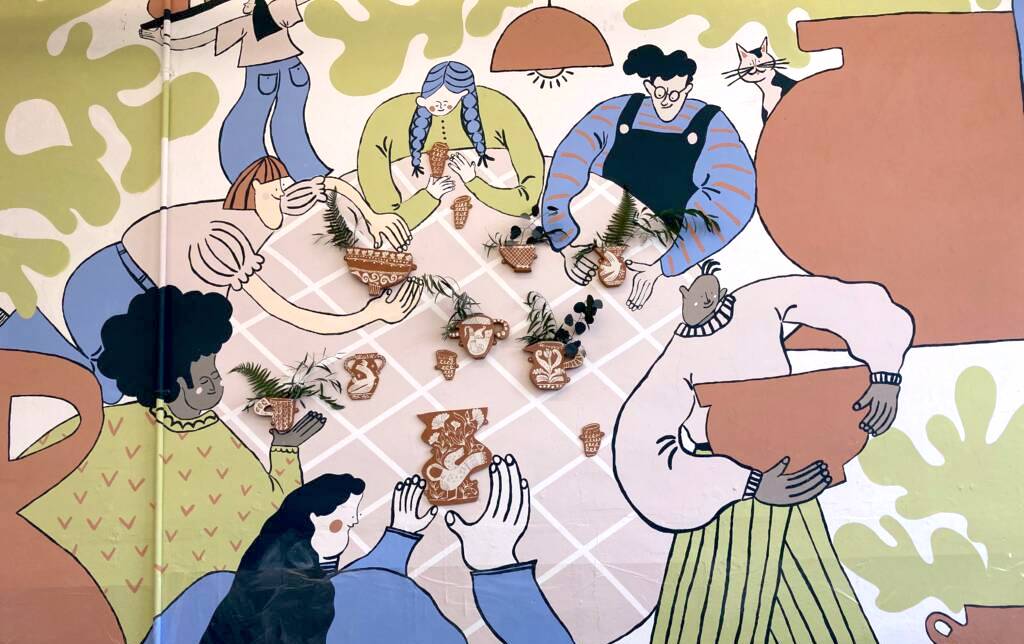
31.07.23

Often, these projects sit on a foundation of an individual’s particular passion for their chosen creative field but end up providing more benefit to the broader community than was ever expected. For our last interview in the series, we’re speaking to one of the city’s best-known and longest-running collectives: Dundee Ceramics Workshop.
Dundee Ceramics Workshop (DCW) is run by Tin Roof Arts Collective, a charity founded by DJCAD graduates in 2010 (hear their story and ambitions in this PechaKucha from 2013). Originally based in an old industrial warehouse, Tin Roof provided space for the creative community to come together through workspace, events and shared resources that enabled both graduates and established artists to develop their practice in Dundee. After sadly losing their space in 2016, Tin Roof launched DCW and have since focused on making ceramics an accessible craft through provision of workspace, kiln hire, tools and tuition for artists and enthusiasts.
We spoke with Euan Taylor – artist, founding member of Tin Roof and current DCW board member – and Steph Liddle – ceramicist and DCW’s Senior Technician – about the organisation’s transformation over the past 12 years, the burnout of running DIY collectives, and the key support that any creative person or project needs to truly thrive.
CD: Let’s start with a bit of history. How did Tin Roof begin?
Euan Taylor: So I guess it was a kind of meeting of a few of us interested in space in the city really. For me personally, I’d already been subletting a space from Downfield Musical Society in the building on Ure Street for a couple of years with my dad. He worked for Gardyne Theatre and built the sets for their shows, and I worked with him for the college, but the college workshop was being gutted and rebuilt so we needed to rent our own space. At that time, the Musical Society built and stored all their own sets too, but then their accountant looked at the cost of having the space and said it wasn’t viable to keep making everything. But by that point I knew the landlord personally, so I was able to approach him and say “Look, I’ll rent it off of you”. At the same time, Jo [Joanna Helfer, Board Member] and Emma [Alexander, Founding Member] had been speaking to the leasing agent for the space; I think they’d already had a tour of it and it transpired they were wanting to do something similar, have a space to work on their own stuff. I knew them both from college already, so we approached each other and teamed up. We moved in in 2011, and at its peak we had something like 27 artists working out the warehouse. There were times where the lights were never off. Everyone had their studio, which was rented for £60 a month, and then to one side there was a big white space which you could book or use, and there was a shared wood workshop too. All the tools, machinery, drills; that was all available for everyone to use.
CD: A big part of the difference between other studio spaces and Tin Roof was that communal workshop. Where did the equipment come from?
ET: A lot of the gear was basically my dad’s. When the Gardyne Road campus was being refurbished, I’d been given the job of clearing everything out, and my dad can be a massive hoarder. He’d been in the same workshop since 1979, so there was a lot of stuff and all of it was going to end up in a skip somewhere and so I rescued a lot of it from there. We did also have a bandsaw that we acquired in that sort of co-operative model, where like 18 of us chipped in a tenner and we were able to buy one. I think my hope was that that model was going to continue too. I realised then that I was really spoiled because of that upbringing with my dad, because I had access to tools. There’s just some simple stuff like a hammer, or very basic equipment that if you don’t have it and you don’t have a lot of money, it takes a long time to build up a very small toolkit. So having it in one space made a big difference. A lot of stuff got made using that rescued equipment.
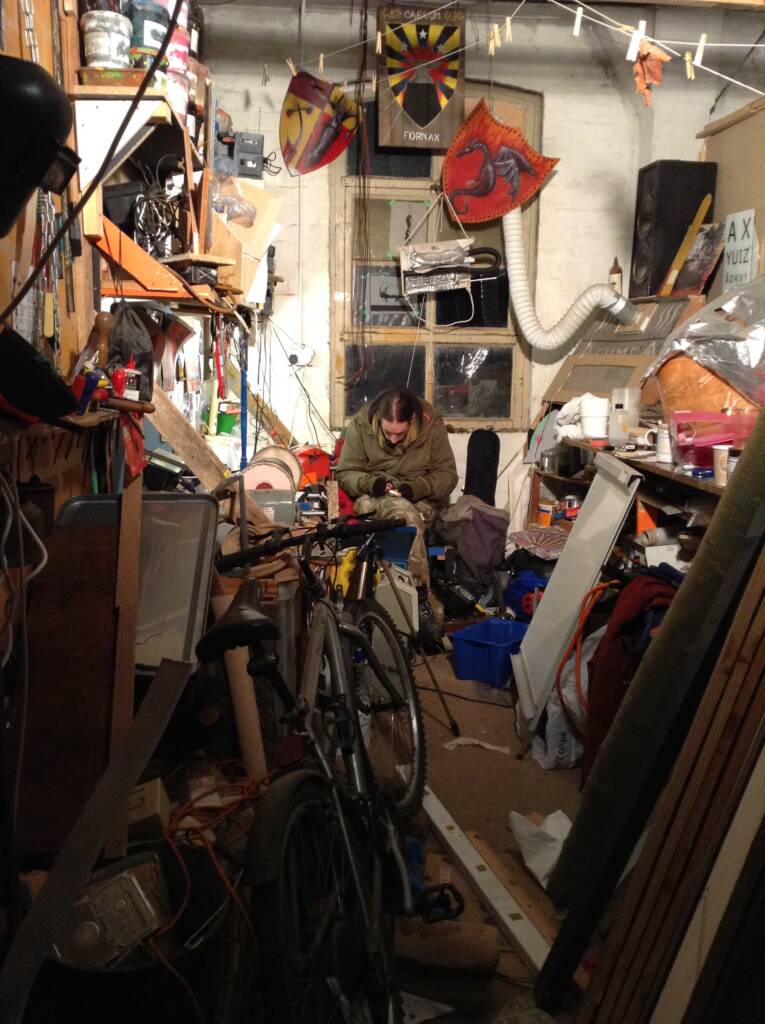
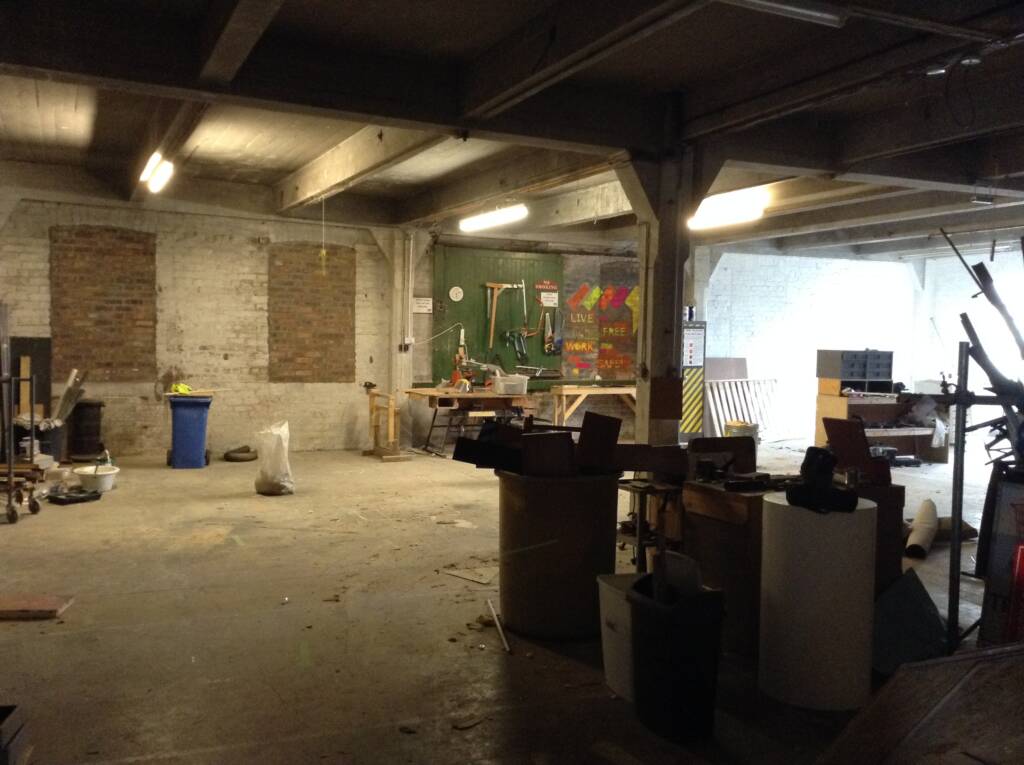
CD: What was the studio space like to work in?
ET: It was always cold. I think it was actually made to be cold in the design of the building. But it was the kind of cold that soaked in through your feet, into your knees. I think when my dad and I first moved in, it was the year with the really massive snowfall, and all of the snow that was on the roof melted and flooded the space. There were two levels that were just two, three inches deep in water, and the first thing we did was shovel it out. It always leaked, and the landlord rigged up some strange sort of water gathering system which sort of worked but there was always a puddle of water. It was a climate in itself really. I mean, there was one time it was foggy inside the warehouse, and I don’t know how it managed that. But we did have a toilet, and we worked really hard when we first moved in to put in a kitchen, so we had a central space where people could come together, to make it more workable.
CD: And what was your relationship with the landlord like?
ET: There was a mutual understanding that the space was what it was. It was an agreed understanding that it wasn’t the best place in the world but it also wasn’t expensive. And because of that, they were very lax on what we could do with it. They had nothing against us adapting the space, and that was the pay off. We did a lot of our own improvements to the space when we were there, you know, trying to stop it leaking and repairing the fire exit, and we had just begun to sort out the electrics when we were kicked out. The whole space’s power went through a cable about the thickness of a pencil. You couldn’t boil the kettle and have a heater on because the electrics would cut. So we invested a bit of money into the space too. I think the crux of it was that we never ever signed a proper lease. The lease we were given said weird things like “You need to paint the windows and sills yearly and in workmanlike fashion” and we weren’t going to sign that because we weren’t going to do that, so we put a lease to him that was more like the lease we wanted and then that just went back and forth between us for years. I don’t think anything was ever signed. So we were on a shaky peg and I think these things are always on a knife edge.
CD: How did the shut down come about?
ET: So it was 2016 by then, and someone from the council saw the space and freaked out. And at the same time, 71 Brewing had come along and said they’d rent the space and renovate it. We could have fought it, kicked up a stink, gone to the press, but I think really, by that point we didn’t have anything left in the tank to fight it. We were all exhausted. Everyone had their own struggles and we were kind of at our limit for what we could give for nothing, voluntarily. I mean, for myself, I think I’d been working a year full time at a skip yard, so I was working out in the cold all day, and I couldn’t cope with finishing work there and then going to Tin Roof and being in the cold there for a few more hours. I got trench foot from working in the skip yard all day and I was burst. Everyone had their own struggles that were going on.
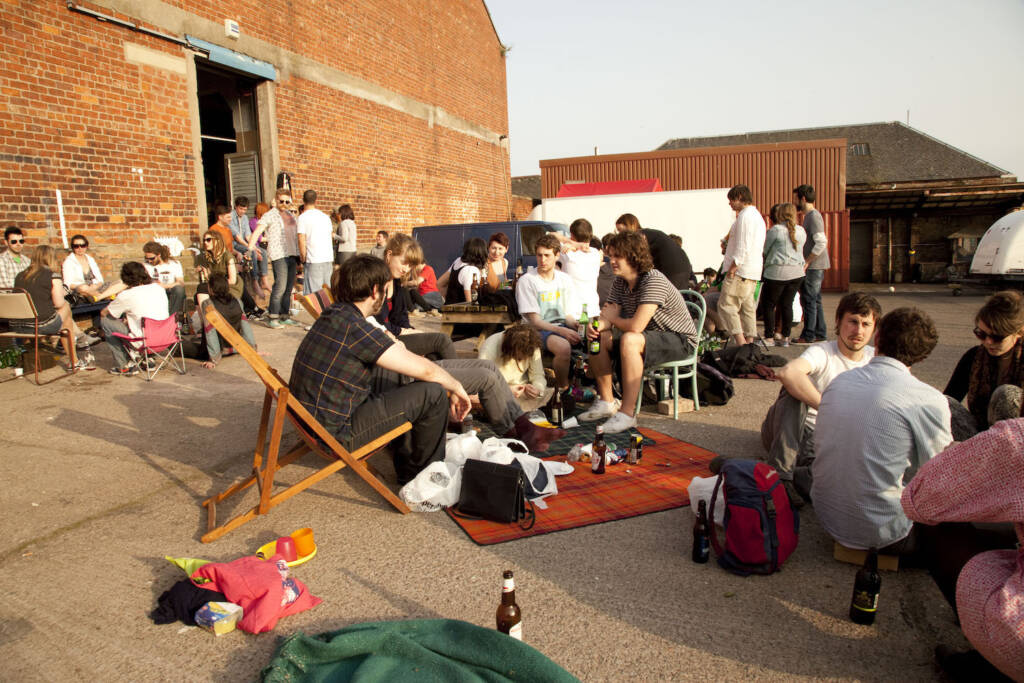
CD: So how did Tin Roof morph into its current form of Dundee Ceramics Workshop?
Steph Liddle: So I joined the Tin Roof committee just as they got kicked out of the original space and, just before then, an application had gone to Creative Scotland for funding to set up a ceramics studio within Tin Roof. There’d already been a pug mill donated, and then two second-hand kilns had been donated from a school in Perth, which had already had a long and fruitful life before they came to us. One of them is still the one we currently have in the workshop, which is kind of on its last legs but it’s a big front loader, and then there was a small top loader too. I think that the letter to say that the funding had been successful came through on the same day that you found out you were losing the space? It was really such shit timing. So there were a good few months of not having anywhere, but the funding was still there for the ceramics part, so the plan became to move into a smaller space next to Wasps, which is how Dundee Ceramics Workshop came to be.
CD: You’re now based across two studio spaces in Wasps Meadow Mill itself. How does that set up work for you?
SL: We’ve actually just swapped the workshop spaces around at the start of the year to give us a bit more space. 413 is the studio space now, where we’ve got desks for people to rent out from us. We used to have four, but now there’s seven total, which is great! It’s a decent-sized studio so each person has a desk and storage space and it’s really nice that we’re able to provide quite affordable studio space there. The big space in 216 is where the kilns are, where workshops and tech stuff happens, and where members come in for open access days. That’s been a really good move and I think it’s helped to develop that sense of community a bit more, with the main space being busier. It has been tricky though; Wasps is getting increasingly expensive. This year alone, he rent [which is inclusive of bills and an electricity surcharge] has gone up 27% and then if you have a kiln, you pay for that electricity usage too. It’s becoming harder and harder to sustain a practice, so the focus just now is making changes and finding ways to give us a bit more financial security month to month.
CD: Talking of finances, you’re a registered charity, but money-wise you’re self-sustaining. How does that work in practice?
SL: Most of our money still comes through workshops and classes which subsidise a lot of the workshop access and means we can keep the price of those very low in comparison to a lot of other ceramics workshops across Scotland. That accessibility is really important. The reason Tin Roof applied for the funding in the first place was because it was impossible to access a kiln in Tayside at that point, so anyone trying to make ceramics had to either buy their own kiln or find someone who was willing to fire your work for you, which was really difficult. Our membership prices are still probably the lowest in Scotland to try and make our space as accessible as possible for as many people as possible. Lauren [Swan, Workshop Coordinator] has been putting a bit of work into our membership structure recently too, to give more options for people to access the space at different price points.
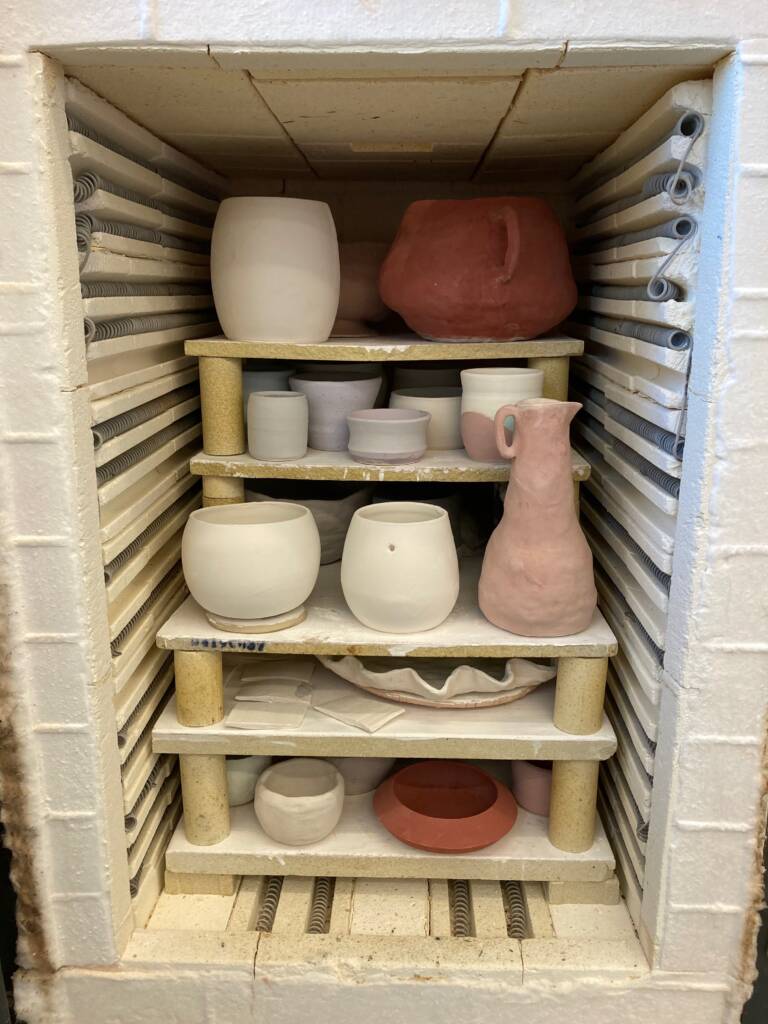

CD: And how does the decision making happen within the organisation? What does the structure look like?
SL: At the moment we’ve got the Board, which is Euan, Jo and Tanith, then we’ve got staff, which is myself as Senior Tech, Rachel Corr who’s Junior Tech and Lauren Swan too. And then we’ve got the voluntary committee, who aren’t super active at the minute but we’re recruiting for new members so that’ll change soon. And then our volunteers. We’re just making some changes to what everyone’s roles are at the moment, but widely, the Board directs the overall decisions of what we’re doing. Staff deal with the operational side of things, and the committee are in charge of a lot more of the events stuff, community outreach, the fun stuff. Our volunteers have less of a commitment than committee members, but are more of a physical presence in the space; they open the studio up for open access sessions, they help with our workshops and in return, they can use the facilities for free. Committee members are more like a thinking presence, they generate ideas.
CD: It’s got a lot of moving parts!
ET: I would say that you definitely need paid people to manage it all. It’s great having volunteers and a committee, but you definitely have to have a staff position to try to coordinate it. That’s a full time job, really.
SL: And that’s what a big part of Lauren’s job is; she’s managing all the volunteers, sorting out the classes. The workshop wouldn’t function without Lauren and her organisational skills and beautiful spreadsheets. All of the staff team are part time, between us we have just over one full time member of staff. Lauren is 20 hours a week and it’s a lot for one person to do in that time, especially when it comes to organising volunteers. The big issue the staff are having at the moment collectively is trying to get other people to understand that we’re part time. We’ve got a lot of outside organisations who want to work with us who don’t understand that we’re not constantly available, and that when we’re in our own studios, we’re working on our own practices, doing our other jobs.

CD: What do the future plans for Dundee Ceramics Workshop look like?
ET: I think the ghosts of Tin Roof are still in Dundee Ceramics Workshop. Certainly, until lately, the long term plan was to find something else like Tin Roof but we’d need a lot of energy to do that. It’s not just me that makes the decisions but I personally think, for now, keeping ceramics as the focus is the priority. There is still a part of me that would love to build a massive studio complex though.
SL: There is so much energy from creatives across the city who want something similar to what Tin Roof had to offer, or an improved version of what it was. I know myself, I have dreams of similarly creating a big studio complex; there’s a high school I’ve got my eye on but quite frankly I don’t have half a million pounds to buy it. But it’s been on my mind a lot recently, just how great that would be as an alternative to Wasps as a studio space that could embody so much of what the Tin Roof energy was and is. Somewhere that could have studio spaces and a gallery, a workshop for wood and ceramics and metalwork, a playground that can be a yard for outdoor BBQs and raku firings. I don’t know if that dream necessarily comes under the Tin Roof umbrella though.
ET: There are also some big things coming up for us that are more immediate. Like we need another kiln, so we need to try and source funds for that. We’re also trying to streamline people’s jobs and roles so it’s easier and I think there’s enough work in there to keep us going.
SL: I think my and the staff team’s goals are similar; it’s about sustainability. My personal hope is that we can just have a bit more financial security and security of space, whether that is in Wasps or whether at some point we’re somewhere else. And yeah, we need a new kiln. We had two, one of them is now no more, so we’ve only got one and it’s the old banger of kilns. And we do need some really big money injections to be able to make that happen. I’ve put in a few funding applications over the past few months, but I think the staff feel like if we’re putting that energy into writing the funding applications, then we really do want to think big about it. Rather than just putting in an application to cover the cost of one kiln, we want to be applying for two kilns and an extruder, and all this other new equipment to make it worthwhile. In terms of staffing, we’d really love to see us getting to a point where we’ve got paid workshop assistants or someone to help Lauren with more of the basic admin and communications stuff, so she can spend her time focusing more on organising classes and volunteers. And we’d love to get a bit more consistent with our opening hours. If we could have paid workshop assistants, then we could open at set times so that the community who are using the space know when we’re going to be open.
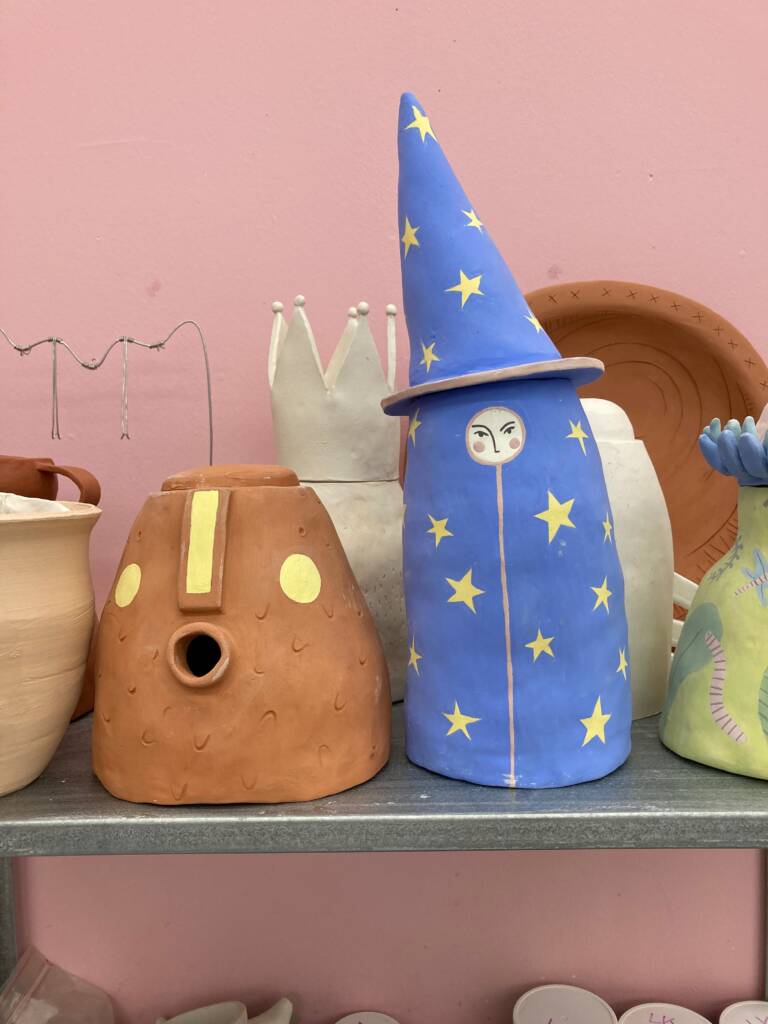
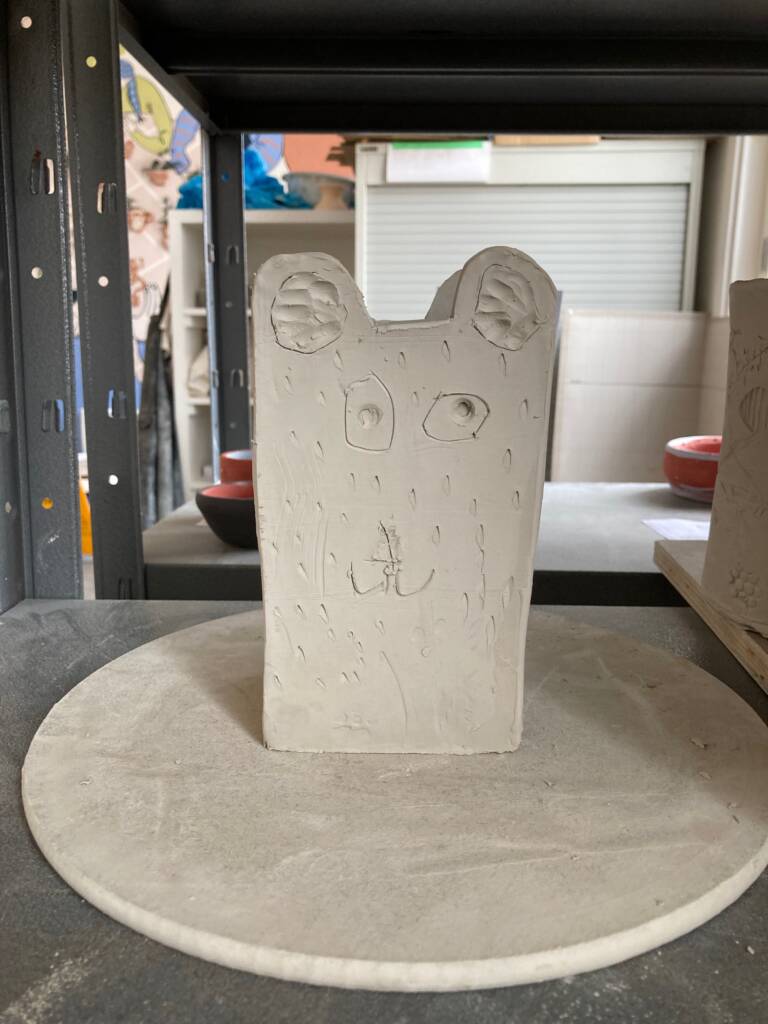
CD: With all that in mind, is there something you’d love to see happening in the city that would help support Dundee Ceramics Workshop going forward?
SL: I think space is a big issue. I’ve got so much to say about this just generally, about how artists aren’t able to function, not just in Dundee. But space – warm space, comfortable space, affordable space – is a huge one. I feel like at the moment in Dundee there’s a lot of things popping up that are coworking spaces or hotdesks, and that’s fine if you’re a creative who works on their laptop all day, but if you’re a ceramicist or sculptor or maker or someone who just has a messy mind and needs to spread out, it just doesn’t cut it. Some of us need space we can make a mess in and not be scared to make a mess in, where we can spread out rather than containing those ideas to a desk. At the moment I think Wasps is so unattainably expensive for a lot of people that it then puts a pressure on people to think commercially about their work and their practice as a business. Basically, how you’re going to make money off of your ideas is always at the forefront of your mind, which diminishes how much time and space and energy you have for creativity and play and new ideas which ultimately damages your practice in the long run.
ET: I think a lot of the things that would help support artists are bigger, more systematic changes. Time’s a big issue too. Implementing the four-day work week would make such a difference. I work a 45-hour week plus overtime, and I’m trying to do voluntary stuff too, and there’s nothing left. I think the people that are willing to give up their time to these projects don’t tend to have much of it to give. It’s that saying: if you want something done, ask a busy person. I think, more practically, in the context of what would help institutions like us out in the day-to-day would be some help with the stuff artists aren’t trained to do but inevitably have to end up doing as we run these organisations. It’s an idea my friend Stephen Murray from the Edinburgh Sculpture Workshop had, for a travelling board that could drop in on the various arts institutions annually or bi-annually, made up of people like a solicitor, an accountant, people with business and funding expertise that could help guide us in these things we don’t know how to do, that could support us – that would make such a difference.
SL: And funding. I will bang on until the end of time about the need for a universal basic income, especially for creatives and artists. Space and money and time, it’s what it all comes down to.
ET: Ultimately, if everyone had more time, we’d have more time to care for the city.
A massive thank you to Euan and Steph for sharing with us. There are lots of ways you can support Dundee Ceramics Workshop’s wonderful work: try one of their many classes, join as a member to get access to space and resources, or help keep the workshop running with a donation. You can also volunteer your time in exchange for studio access!
Whilst you’re here, catch up on our previous Collective in the City interviews with Make-That-A-Take Records, Volk Gallery, Elfie Picket Theatre, Biome Collective, Hotchpotch, CHIP Collective, Double Door Studios and Dundee Fringe too.

If you would like to support us in creating even better content, please consider joining or supporting our Amps Community.